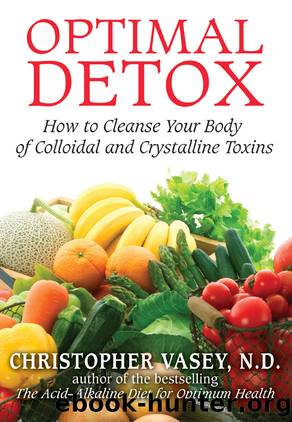Optimal Detox by N.D. Christopher Vasey

Author:N.D. Christopher Vasey [Christopher Vasey, N.D.]
Language: eng
Format: azw3, mobi
Tags: Health/Detox
Publisher: Inner Traditions / Bear & Company
Published: 2002-01-02T00:00:00+00:00
Varicose Veins
This is deformation of the veins, generally in the lower limbs, due to an accumulation of blood. The pressure the blood imposes on the vein walls causes them to dilate. They become deformed and twisted. This phenomenon can be seen easily when the veins are near the surface. Varicose veins are accompanied by a sensation of heaviness in the legs, sometimes accompanied by itching. The poor circulation that is the basis for varicose veins is caused by blood that is too thick, which makes it difficult to flow upward toward the heart.
Hemorrhoids
These are varicose veins in the region of the anus. They are also caused by overly thick blood. The colloidal nature of this disorder is given added emphasis by its connection to the liver, the organ charged with the duty of eliminating colloidal wastes. The veins in the anus are connected to the portal vein, which goes to the liver. When this organ is congested with wastes, the venous blood transported by the portal vein cannot flow freely through the liver and back into general circulation. This blood accumulates there, and its mass puts pressure on the vessels. The most vulnerable part of these vessels, the veins of the anus, suffers the consequences.
Arteriosclerosis
When colloidal substances—fats and cholesterol—are overly concentrated in the bloodstream, they cannot all be filtered from the blood by the liver. Some of them will form deposits on the walls of the blood vessels. There they form atheromas, or yellowish lumpy deposits. These deposits will grow larger and more extensive if they continue to be supplied with the colloidal wastes that formed them. In reaction to the presence of these foreign bodies a fibrous tissue is formed. This causes the vessels to lose their flexibility (sclerosis). With the accumulation of these deposits and the increase of this fibrous tissue, the diameter of the vessel becomes gradually smaller. The blood flow is obstructed. This in turn means that the organs irrigated by these vessels receive less and less blood. Arteriosclerosis is not painful on its own. It only starts to hurt when a vessel becomes very briefly clogged. In the heart area this translates into angina pectoris; in the calves it reveals its presence through intermittent cramping pain, which impairs walking.
High Blood Pressure
Blood that is too thick will have difficulty circulating, making the bloodstream flow more slowly. In addition, this will cause the organs (kidneys, liver) traversed by these blood vessels to become overburdened with wastes, just as the vessels themselves (atheroma). All of these factors combine to hamper blood circulation even more. In reaction to this situation, the heart increases the force it uses to circulate the blood. This inevitably results in a rise in blood pressure.
Heart Attack and Stroke
The blood can eventually become so thick that it coagulates and forms a clot. This clot can clog a vessel completely, which causes an interruption in the blood supply to the area of tissue dependent on the vessel. Once the supply stops, the tissue dies. This is
Download
This site does not store any files on its server. We only index and link to content provided by other sites. Please contact the content providers to delete copyright contents if any and email us, we'll remove relevant links or contents immediately.
| Acupuncture & Acupressure | Aromatherapy |
| Ayurveda | Chelation |
| Chinese Medicine | Energy Healing |
| Healing | Herbal Remedies |
| Holistic | Homeopathy |
| Hypnotherapy | Massage |
| Meditation | Naturopathy |
| Reference |
Inner Engineering: A Yogi's Guide to Joy by Sadhguru(5893)
The Power of Now: A Guide to Spiritual Enlightenment by Eckhart Tolle(4752)
Fear by Osho(4084)
The Art of Happiness by The Dalai Lama(3382)
The Ultimate Bodybuilding Cookbook by Kendall Lou Schmidt(3316)
Yoga Therapy by Mark Stephens(3222)
Ikigai by Héctor García & Francesc Miralles(3139)
The Little Book of Hygge by Meik Wiking(3079)
Why Buddhism is True by Robert Wright(2825)
The Healing Self by Deepak Chopra(2794)
Being Aware of Being Aware by Rupert Spira(2704)
Shift into Freedom by Loch Kelly(2691)
Wild Words from Wild Women by Stephens Autumn(2587)
Work Clean by Dan Charnas(2560)
Happiness by Matthieu Ricard(2520)
The Hatha Yoga Pradipika (Translated) by Svatmarama(2481)
Yoga Body & Mind Handbook by Jasmine Tarkeshi(2462)
More Language of Letting Go: 366 New Daily Meditations by Melody Beattie(2442)
Why I Am Not a Feminist by Jessa Crispin(2238)
